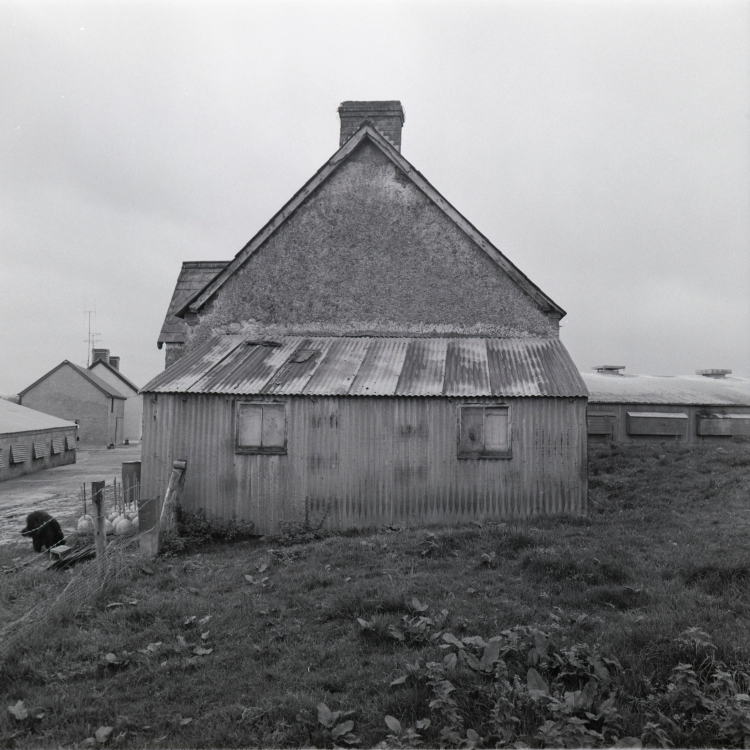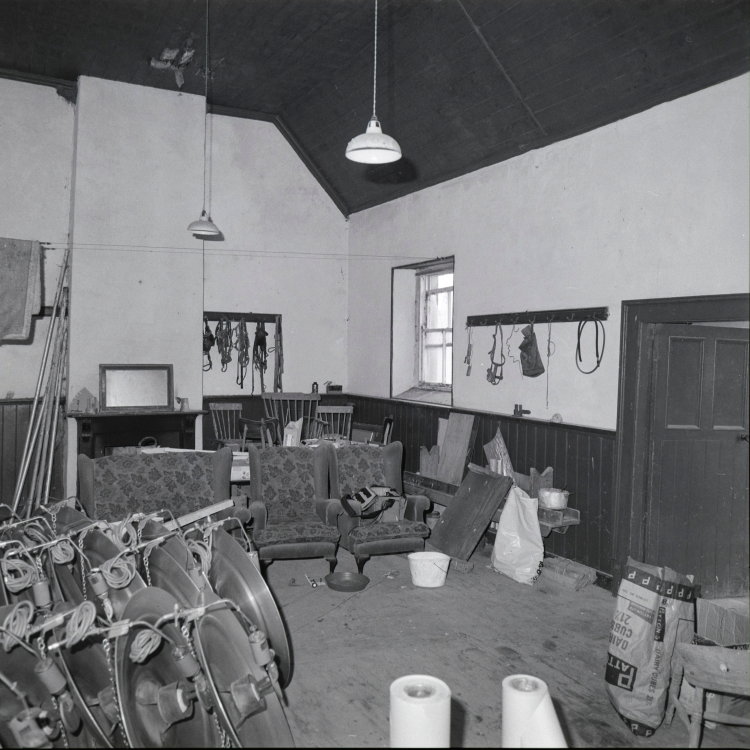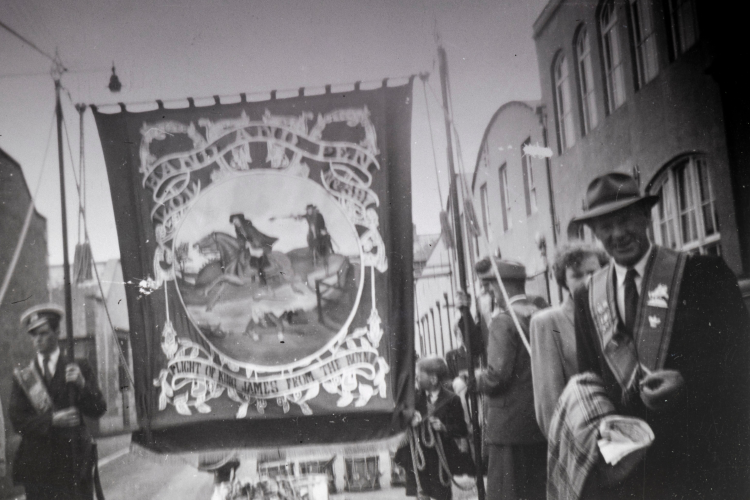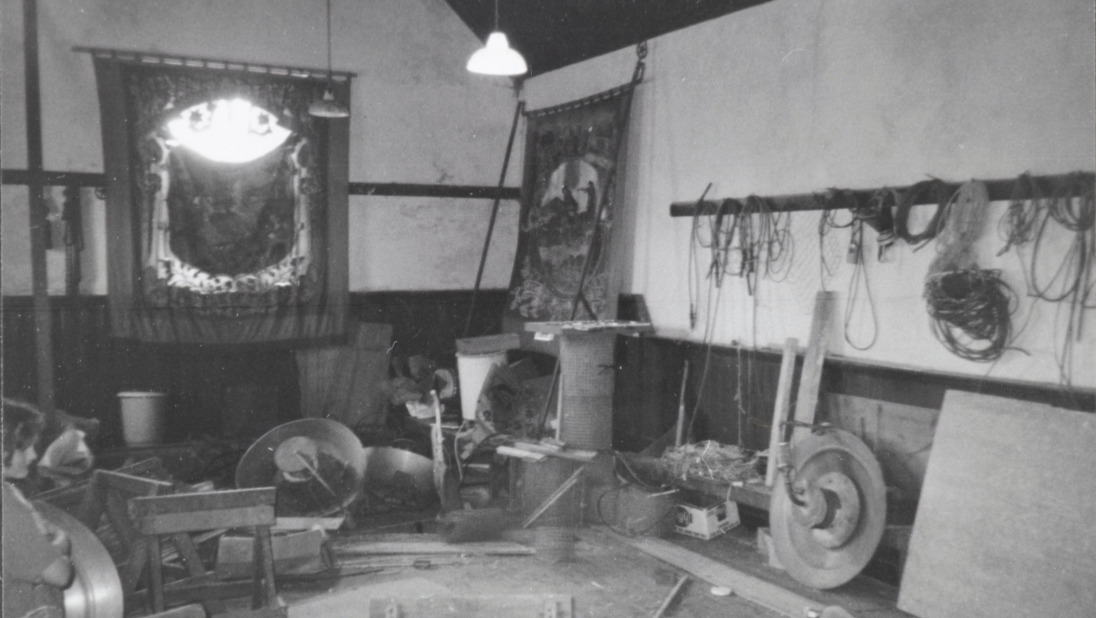
Key Facts
This small country hall was used by the Hand and Pen Loyal Orange Lodge (LOL) no. 597 for its monthly meetings and social events. The layout is typical of small country Orange Halls for the period.
The townland of Corbeg, Silverstream in County Monaghan.
Number 52 on the map, located in the rural ‘field area’.
Built in 1884. The First World War brought the death of several of its members, and with the partition of Ireland in 1921 there was further diminution of the local Protestant population. The hall was brought to the Ulster Folk Museum and opened in 1995.
The lodge’s heyday was before the First World War, when it had a steady membership of 60 to 80 members.
Building Description
The hall’s exterior showcases several interesting features that reflect its heritage. Decorative bargeboards adorn the eaves and the front gable, incorporating a five-pointed star—a distinctive symbol of the Orange tradition. The scalloped slates on the porch add visual contrast to the more conventional roofing used across the rest of the structure.

Inside, the hall's layout is typical of small country Orange Halls from its era. Between 1931 and 1946, the fireplace and platform were repositioned, and an annex was added to the building. However, the museum’s interpretation of the space focuses on its original design, providing visitors with an authentic sense of its historical use and significance.
The Story Behind the “Hand and Pen” Name
The site for the hall was provided by Sir John Leslie, a landlord who owned the land farmed and lived on by the Garland family. Their farm carried the distinctive name “Hand and Pen,” believed to have originated from a local shop sign depicting a hand holding a quill pen writing in a ledger. When the hall was built, this name was carried over, weaving a unique piece of local heritage into its identity.
History of the Orange Order
The Orange Order emerged in September 1795, following the Battle of the Diamond in Loughgall, County Armagh. This conflict reflected the broader tensions between Catholics and Protestants in the area. At its heart was the defiance of buildings belonging to Dan Winter, a local grocer and publican. After their victory at Dan Winter’s cottage, a group of Protestants formed an organised institution, marking the birth of the Orange Order.
Unlike earlier secretive societies, the early Orange Order gained support from Tory gentlemen who were wary of rising republican ideas inspired by the American and French revolutions. These tensions shaped the Order’s identity as it opposed Irish nationalism throughout the 19th century. Although it was sometimes banned for contributing to public disorder, the Orange Order became a cornerstone of Irish - and later Ulster - unionism from the 1880s onward.
The Rituals and Degrees of the Orange Order
The Order's rituals reflect its biblical inspirations, though they have been simplified over time:
- The Orange Degree: Initially based on the themes of the Passover and Exodus, it was simplified in 1800 to a catechism and address.
- The Plain Purple Degree: Rooted in the biblical account of the giving of the law to Moses and the construction of the Tabernacle in the wilderness, this degree reflects the sacred colours of the Ark of the Covenant’s curtains - blue and scarlet. It was simplified in 1820 to a session of questions and answers.
A Turbulent Time in Ireland
The 1790s were a period of unrest in Ireland, especially in Ulster, where agrarian violence was common. Amid this turmoil, the Loyal Orange Institution was formally established on September 21, 1795. Its members, including Orangemen from Newtownards and Upper Ards, joined the Yeomanry and played a role in suppressing the United Irish Rebellion of 1798.
One prominent figure was William Johnston of Ballykilbeg, a folk hero for popular Orangeism. Johnston defied the government’s ban on parades, leading an illegal procession on July 12, 1867, from Newtownards to Bangor to commemorate the Battle of the Boyne.
Orangeism in North Down
The Orange tradition in North Down reflects a strong Huguenot influence, a legacy of the revolution of 1688. Prominent families, such as the Crommelins of Carrowdore and the DeLacherois family of Donaghadee, played key roles in shaping the area's Orange identity.
Today, North Down is home to five Orange districts, each with its own unique history:
- Newtownards
- Upper Ards
- Comber
- Holywood
- Bangor
Life in the Hall
The hall was at the heart of the lodge's activities, providing a space for members to gather and make decisions. Monthly meetings, held on the third Friday of each month, followed a structured agenda, as recorded in the lodge’s minute books from 1912-1929 and 1929-1944. These records show meetings often included:
- Collecting membership dues
- Paying bills
- Proposing and initiating new members
- Disciplining or expelling members
- Opening with prayers and scripture readings (from late 1928, meetings followed a ritual format, led by the chaplain).
Beyond official business, the hall was a lively social hub. Dinners and dances were highlights of the year, especially after the 12th July demonstrations. Social events were held for various causes or special occasions, creating a vibrant community atmosphere:
“I seen some quare nights in the Hand and Pen, dancing till 6 o’clock in the morning... there was a dancing class every Thursday night for years. Marianne Cole was the teacher, and if you were a good dancer, she’d make sure you paired with someone less skilled... Charlie Coleman fiddled the whole night for a half pint of whiskey – six and sixpence back then – that was the band’s fee...”
Wilson Haire
The lodge's band was another source of pride, regularly performing at 12th July demonstrations. Members like William, known for keeping "law and order," ensured events ran smoothly and fostered camaraderie within the group.

Charitable Contributions
The lodge played a vital role in supporting charitable causes within its community and beyond. For instance, it regularly raised and distributed funds to organisations such as the Lord Enniskillen Memorial Orange Orphan Society.
During times of crisis, the lodge's members demonstrated remarkable generosity. In May 1941, amid the Belfast Blitz, a special meeting was held to determine the lodge's contribution to the Lord Mayor’s Fund, established to aid air raid victims in Belfast. Members present donated £2 3s 6d - a substantial sum for the time. Efforts to involve absent members were led by Brothers James Bothwell and Robert Wilson, who were appointed to collect further contributions.
Road to the Folk Museum
Lodge meetings ceased in the early 1980s, as a decline in membership driven by Protestant migration left only a handful of individuals involved. By 1989, the hall was donated to the museum, and in 1994, Enterprise Ulster began dismantling the building for its move to Cultra. The hall was officially opened in 1998, thanks in part to a generous £10,000 sponsorship from the Orange Order. Furnished by Tony Buckley, Curator of Community Life, the hall showcases authentic furniture from local lodges in Co. Monaghan, offering a glimpse into the past with its high-ceilinged room, wooden dais, and period furnishings, including a central table surrounded by chairs, benches, and framed prints. The hall's evocative setting, with a fireplace at one end and carefully curated displays, provides an immersive experience into the once vibrant community gatherings of the past.

Two standout items became part of our collection at the time of donation. One is a captivating banner, painted by Belfast artist William Hewitt, featuring a depiction of King James fleeing the Boyne, pursued by a Williamite soldier wielding what appears to be an early flame-thrower. On the reverse side, the banner presents the more familiar image of the Relief of Derry.

The second item is a bass drum, once displayed on a gable wall. Originally a militia drum, it was resized in the 1920s for use by a fife and drum band associated with the lodge. Hand-painted with scenes of William crossing the Boyne and adorned with Orange lilies, this drum offers a vivid reflection of both the artistry and cultural significance of its time.

Together, these pieces provide a unique window into a rich historical narrative.









